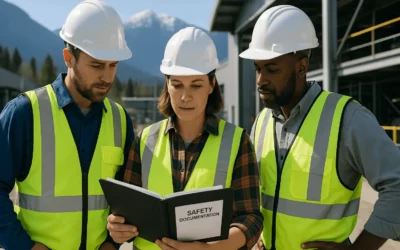Introduction
COR (Certificate of Recognition) Safety Programs are not just a set of guidelines; they are the backbone of safety in various industries, including construction, mining, oil and gas, and more. These programs ensure that safety standards are not only met but consistently exceeded. This guide aims to provide newcomers with a comprehensive understanding of COR and SECOR (Small Employer Certificate of Recognition) programs, unraveling the complexities of training requirements, provincial differences, and mandatory documents.
Safety is not merely a word; it’s a culture, a commitment, and a continuous journey. Whether you’re an employer, an employee, or someone interested in the world of industrial safety, this guide is your starting point. Let’s embark on this journey together, exploring the world of COR and SECOR safety programs.
Disadvantages of Not Being COR Certified

COR certification is more than just a badge of honor; it’s a reflection of a company’s commitment to safety, quality, and responsibility. Without this certification, organizations may face several challenges:
High Incident Rates
Without the structured safety protocols that COR certification promotes, companies may experience higher incident rates. These incidents can range from minor accidents to severe injuries, leading to disruptions in operations and potential legal liabilities.
Excessive Injury Frequency Rate
- What It Is: The injury frequency rate is a measure of how often injuries occur within a specific number of work hours. It’s calculated by taking the number of injuries and dividing it by the total hours worked, then multiplying by a standard figure (e.g., 1,000,000).
- The Impact: A high injury frequency rate indicates a lack of safety measures, leading to frequent injuries. This can tarnish a company’s reputation, affect employee morale, and result in regulatory scrutiny.
Higher WCB or WSIB Premiums
Lack of COR certification may lead to higher premiums for Workers’ Compensation Board (WCB) or Workplace Safety and Insurance Board (WSIB) coverage. These higher costs reflect the perceived higher risk associated with a non-COR-certified company.
Loss of Potential Clients
Potential clients often look at injury frequency rates and COR certification as indicators of a company’s commitment to safety. High injury rates and lack of certification can deter clients, leading to lost business opportunities.
Poor Safety Culture
Without COR certification, a company may struggle to foster a robust safety culture. This lack of focus on safety can lead to:
- Poor Workmanship: Employees who don’t prioritize safety may also neglect quality in their work.
- Lack of Concern for Safety: A lax attitude towards safety can permeate the organization, leading to careless behavior and increased risks.
Conclusion
Not being COR certified is not merely a missed opportunity; it’s a significant business risk. From high incident rates to poor safety culture, the lack of certification can have far-reaching impacts on a company’s success, reputation, and bottom line.
Investing in COR certification is not just about compliance; it’s about building a culture of excellence, responsibility, and care. It’s a commitment to the well-being of employees, the satisfaction of clients, and the overall success of the organization.
Don’t let the absence of COR certification hold your business back. Take the necessary steps to achieve certification, and embrace a future of safety, quality, and success.
Understanding COR and SECOR Programs

COR and SECOR programs are integral to maintaining safety standards across various industries. But what exactly are they, and how do they differ?
COR (Certificate of Recognition) Programs
COR is designed for larger organizations, typically those with more than 10 employees. It’s a voluntary program that recognizes and rewards employers who go beyond the legal requirements in health and safety. Here’s what you need to know:
- Eligibility: Any organization can apply, but it’s more common among medium to large businesses.
- Training: Comprehensive training covering safety guide implementation, risk management, compliance with industry safety, and more.
- Benefits: Potential for reduced insurance premiums, improved employee morale, and enhanced reputation.
SECOR (Small Employer Certificate of Recognition) Programs
SECOR is tailored for small employers, typically those with fewer than 10 employees. It’s a simplified version of COR, making it accessible for smaller businesses. Here’s what you need to know:
- Eligibility: Specifically designed for small businesses.
- Training: Similar to COR but with a more streamlined approach, focusing on essential safety practices. NO external audits are required, in these programs you are the auditor and you conduct.
- Benefits: Like COR, SECOR can lead to reduced insurance premiums and a positive safety culture.
Application Process
The journey begins with the application process, where you’ll need to contact the certifying partner in your province or territory. They will guide you through the application and provide you with the necessary information and resources.
Training of Management
Management must undergo specific training courses provided by the certifying partners. These include:
- Principles of Health and Safety Management: Understanding the core concepts of safety management.
- Leadership for Safety Excellence: Developing leadership skills to foster a culture of safety.
- Auditor Training Course: Learning how to conduct internal audits to ensure compliance.
- WHMIS or TDG Train the Trainer or Legislative Awareness: Specialized training to ensure awareness of specific regulations and the ability to train others.
Return to Work Programs
Developing programs to facilitate the return of injured workers to the workplace, ensuring their well-being and compliance with legal requirements.
Develop Safety Program
Your safety program must be developed based on the audit document’s standards. This includes, at a minimum:
- New Worker Orientations: Introducing new workers to safety protocols.
- Hazard Assessment and Control: Identifying and managing potential risks.
- Incident Investigation: Procedures for investigating accidents or incidents.
- Emergency Response Plans: Preparing for unexpected emergencies.
Policies

At a minimum, you’ll need policies related to:
- Health and Safety [mission statement]
- PPE Policy
- Preventative maintenance policy
- Emergency Response
- Incident Reporting
- Hazard Management
- Violence and harassment policies
Violence and Harassment: A Zero-Tolerance Approach
In today’s workplace, there is no room for violence or harassment. Employers must take a proactive stance to protect their workers, ensuring a safe and respectful environment for all. This commitment goes beyond mere words; it requires concrete actions, training, and protocols.
Understanding Violence and Harassment
Violence and harassment are not limited to physical acts. They can include verbal abuse, intimidation, threats, and any behavior that creates a hostile work environment. Understanding what constitutes violence and harassment is the first step in combating them.
Employer Responsibilities
Employers must:
- Develop Policies: Clear policies must be in place, outlining the organization’s stance on violence and harassment.
- Provide Training: Workers must be trained on what violence is and why it’s not acceptable in the workplace.
- Implement Reporting Protocols: A confidential and effective reporting system must be in place, allowing workers to report incidents without fear of retaliation.
- Take Action: Employers must act promptly to investigate and address any reported incidents.
Worker Training
Workers must be trained on:
- Definition of Violence and Harassment: Understanding what constitutes unacceptable behavior.
- Ways to Avoid Violent Confrontations: Techniques and strategies to de-escalate situations and avoid confrontations.
- Procedures for Encountering Violence Outside the Office: Specific protocols for handling incidents in the field, including reporting and seeking assistance.
- Support Resources: Information on available support, such as counseling or employee assistance programs.
Items Workers Must Be Trained On
- Recognizing Signs of Violence and Harassment: Identifying behaviors that may lead to violence or constitute harassment.
- Communication Skills: Effective communication to resolve conflicts and express concerns.
- Reporting Procedures: How and where to report incidents, ensuring confidentiality and support.
- Personal Safety Measures: Techniques to protect oneself in potentially violent situations, both in the office and in the field.
- Legal Obligations and Rights: Understanding the legal framework related to violence and harassment in the workplace.
Conclusion
Violence and harassment have no place in a professional setting. Employers must take a firm stance, backed by policies, training, and a commitment to action. Workers must be empowered with the knowledge and tools to recognize, avoid, and report incidents.
By fostering a culture of respect, empathy, and zero tolerance for violence and harassment, organizations can create a workplace where everyone feels safe, valued, and supported.
Certifying partners usually have demo policies that you can adapt to suit your needs. Consult with them to find the appropriate templates and guidance.
Organizational Chart
Developing an organizational chart helps identify different roles within your company, clarifying responsibilities and ensuring alignment with safety requirements.
Formal Hazard Assessments
Conduct formal hazard assessments for each position in the company. Workers must be involved in this process by law, ensuring that assessments are accurate and comprehensive.
Educate and Train Workers
Workers must be trained for their specific jobs or positions. Examples include WHMIS, First Aid, H2S Alive, Forklift Training, Fall Protection, etc.
Implementation and Documentation
Implement everything developed and gather documentation for a minimum of 3 months in Alberta and up to 1 year in other provinces. Some provinces offer letters of intent or temporary COR certifications, allowing you to bid on work while working towards your COR programming. Check with your certifying partner to avoid surprises.
Role of Safety Consultants

Safety consultants play a vital role in helping navigate the COR process. Their expertise and guidance can streamline the process, ensuring compliance and success.
Conclusion
Achieving COR or SECOR is not just about ticking boxes; it’s about building a culture of safety that permeates every aspect of your organization. From training management to involving workers in hazard assessments, each step is integral to creating a safe and compliant workplace.
Remember, each province or territory may have unique requirements, so always consult with your certifying partner and consider engaging a safety consultant to guide you through the process.
Differences Between COR and SECOR
While both programs aim to enhance safety, they differ in their approach and applicability:
- Size of Business: COR is for larger businesses, while SECOR is for smaller ones.
- Training Requirements: COR requires more extensive training, while SECOR offers a simplified version. No external auditor is required.
- Certification Process: The process for obtaining COR may be more rigorous, reflecting the complexity of larger organizations.
Training Requirements
Training is the heart of COR and SECOR programs. It’s not just about learning the rules; it’s about embedding a culture of safety within the organization. Here’s a detailed look at the training requirements:
Safety Guide Implementation
- What It Is: Understanding and implementing the safety guide is the foundation of COR and SECOR programs.
- Why It’s Important: It ensures that everyone in the organization is on the same page regarding safety protocols.
- How It’s Done: Through workshops, online courses, and on-site training, tailored to the specific industry.
Risk Management
- What It Is: Identifying, assessing, and mitigating risks.
- Why It’s Important: It helps in preventing accidents and ensuring a safe working environment.
- How It’s Done: Through systematic risk assessments, regular reviews, and implementing control measures.
Compliance with Industry Safety Regulations
- What It Is: Adhering to the specific safety regulations of the industry.
- Why It’s Important: Compliance ensures legal protection and maintains the integrity of the organization.
- How It’s Done: Regular audits, continuous training, and staying updated with the latest regulations.
Provincial Differences in COR and SECOR Programs
Different provinces in Canada have unique requirements and limitations for COR and SECOR programs. Understanding these differences is crucial for compliance and effective implementation.
Ontario

In Ontario, only COR programs are available, with no SECOR or small employer programs. Here’s what you need to know:
- COR Programs: Tailored for medium to large businesses, focusing on comprehensive safety training and adherence.
- Training Requirements: Extensive training covering all aspects of safety, including risk management, emergency response, and industry-specific regulations.
- No SECOR: Unlike other provinces, Ontario does not offer SECOR programs, reflecting its focus on larger organizations.
British Columbia
British Columbia has specific requirements for both COR and SECOR programs:
- COR Programs: Similar to other provinces but with unique provincial regulations.
- SECOR Programs: Available for businesses with up to 20 persons, making it more accessible for small employers.
- Training Requirements: Both COR and SECOR require training in safety guide implementation, hazard assessment, and more, tailored to British Columbia’s regulations.
Alberta
Alberta’s approach to COR and SECOR programs is distinct, with specific limitations:
- COR Programs: Comprehensive and aligned with Alberta’s unique industrial landscape.
- SECOR Programs: Available for businesses with up to 10 persons, reflecting a more restricted approach compared to other provinces.
- Training Requirements: Alberta’s training emphasizes risk management, emergency preparedness, and compliance with provincial regulations.
Saskatchewan
Saskatchewan’s approach to COR and SECOR is flexible and accommodating:
- COR Programs: Available for larger businesses, with comprehensive training requirements.
- SECOR Programs: Permits programs for up to 20 persons, aligning with the needs of small employers.
- Training Requirements: Focus on safety guide implementation, hazard assessment, and Saskatchewan-specific regulations.
Manitoba
Manitoba aligns with Alberta in its approach to COR and SECOR programs:
- COR Programs: Similar to other provinces but with unique Manitoba regulations.
- SECOR Programs: Available for businesses with up to 10 persons.
- Training Requirements: Emphasis on risk management, emergency response, and compliance with Manitoba’s regulations
Quebec
- COR Programs: Similar to other provinces but with unique Quebec regulations.
- SECOR Programs: Currently not offered at this time.
- Training Requirements: Emphasis on risk management, emergency response, and compliance with Quebec regulations
Nova Scotia
- COR Programs: Similar to other provinces but with unique Nova Scotia regulations.
- SECOR Programs: Se-Cor is not offered currently.
- Training Requirements: Emphasis on risk management, emergency response, and compliance with Nova Scotia regulations
New Brunswick
- COR Programs: Similar to other provinces but with unique New Brunswick regulations.
- SECOR Programs: Safety Certified Program is offered, which is similar to Secor.
- Training Requirements: Emphasis on risk management, emergency response, and compliance with New Brunswick regulations
Prince Edward Island
- COR Programs: Prince Edward Island is the only province in Canada not to offer a certificate of recognition program. Instead, they base OH&S programs on internal responsibility.
- SECOR Programs: they don’t offer a se-cor program currently.
- Training Requirements: currently there are no training requirements
Newfoundland
- COR Programs: Similar to other provinces but with unique Newfoundland regulations.
- SECOR Programs: Se-cor is not offered currently
- Training Requirements: Emphasis on risk management, emergency response, and compliance with Newfoundland regulations
Yukon
- COR Programs: Similar to other provinces but with unique Yukon regulations.
- SECOR Programs: Available for businesses with up to 10 persons.
- Training Requirements: Emphasis on risk management, emergency response, and compliance with Yukon regulations
Northwest Territories
- COR Programs: Similar to other provinces but with unique Northwest Territories regulations.
- SECOR Programs: Se-cor programs are currently not available.
- Training Requirements: Emphasis on risk management, emergency response, and compliance with Northwest Territories regulations
Mandatory Documents in COR and SECOR Programs

Compliance with COR and SECOR programs requires several mandatory documents. These documents are not mere paperwork; they are the building blocks of a robust safety culture.
Policies
- What They Are: Clear guidelines and procedures outlining safety protocols.
- Why They’re Important: They ensure consistency and clarity in safety practices.
- How They’re Created: Tailored to the organization’s needs, often developed with the help of safety experts.
Hazard Assessment
- What It Is: A systematic process to identify and evaluate potential risks.
- Why It’s Important: It’s the first step in preventing accidents and ensuring a safe working environment.
- How It’s Done: Regular assessments, involving employees, and using standardized tools.
Emergency Response
- What It Is: Preparedness plans for unexpected incidents, such as fires, spills, or accidents.
- Why It’s Important: Quick and effective responses can save lives and minimize damage.
- How It’s Done: Developing clear procedures, regular drills, and coordination with emergency services.
Fire
- Fire Extinguishers: Properly maintained and easily accessible.
- Fire Alarm Systems: Regularly tested and fully functional.
- Evacuation Plan: Clearly marked escape routes and assembly points.
- Training: Regular fire drills and training on using fire-fighting equipment. Drills are required at least annually for the Cor program.
Violence
- Reporting Protocols: Clear procedures for reporting violent incidents.
- Security Measures: Adequate security measures to protect employees.
- Training: Education on recognizing and de-escalating potentially violent situations.
Injuries
- First Aid Kits: Easily accessible and well-stocked.
- Trained Personnel: Staff trained in basic first aid.
- Emergency Contacts: List of emergency medical contacts readily available.
Evacuation
- Evacuation Routes: Clearly marked and unobstructed.
- Assembly Points: Designated safe areas for gathering after evacuation.
- Training: Regular drills to ensure everyone knows the procedures.
Severe Weather Conditions
- Weather Monitoring: Regular monitoring of weather conditions.
- Shelter Areas: Designated safe areas for shelter during severe weather.
- Communication Plan: A system to notify employees of weather-related emergencies.
Tornado
- Tornado Safety Plan: Specific procedures for sheltering during a tornado.
- Training: Regular drills and education on tornado safety.
Snow Storms
- Winter Safety Supplies: Adequate supplies such as blankets, food, and water.
- Communication Plan: Procedures for notifying employees of storm-related decisions.
Wildfires
- Wildfire Safety Plan: Specific procedures for responding to nearby wildfires.
- Evacuation Plan: Clearly defined evacuation routes and procedures.
Fire and Explosion
- Prevention Measures: Regular inspection and maintenance of potential sources of ignition.
- Response Plan: Specific procedures for responding to fires and explosions.
- Training: Education on recognizing and responding to fire and explosion risks.
Building Collapse or Structural Failure
- Building Inspection: Regular inspection of structural integrity.
- Evacuation Plan: Procedures for safe evacuation in case of structural failure.
- Emergency Contacts: List of contacts for structural engineers or other experts.
Conclusion
Emergency response planning is not a one-size-fits-all process. It requires careful consideration of the specific risks and needs of your workplace. Regular training, clear communication, and well-maintained emergency equipment are essential to ensuring that everyone knows what to do in an emergency.
By meeting these minimum requirements, you create a foundation for a robust emergency response plan, contributing to a safer and more resilient workplace.
Other Essential Documents

- What They Are: Specific documents such as training records, inspection reports, incident reports, etc. Legislative requirements exist for things like working at heights, confined space entry, and dangerous goods training is required if you transport even fuel in half-ton trucks. Your cor or se-cor audit protocols should provide you with all the documentation needed for certification.
- Why They’re Important: They provide evidence of compliance and continuous improvement. You need a minimum of 3 months of documentation, but some certifying partners require a year’s worth. It is important to do mock audits to make sure you are not missing any crucial documents for your certification.
- How They’re Created: Regular updates, employee involvement, and alignment with legal requirements. Workers fill out hazard assessments daily, supervisors do worksite inspections monthly, and equipment has pre-check or pre-use checklists filled out by workers or operators before equipment is used.
Conclusion
Understanding and implementing COR and SECOR safety programs is not just a legal obligation; it’s a moral and ethical commitment to the well-being of every individual in the workplace. From Ontario’s focus on COR programs to British Columbia’s flexibility in SECOR, provincial differences must be carefully considered. Mandatory documents, training requirements, and a culture of safety are the cornerstones of these programs.
Whether you’re in British Columbia, Alberta, or any other province, embracing COR and SECOR programs is a step towards a safer, more productive, and more responsible workplace. Start your journey today and make safety not just a word but a way of life in your business success!



